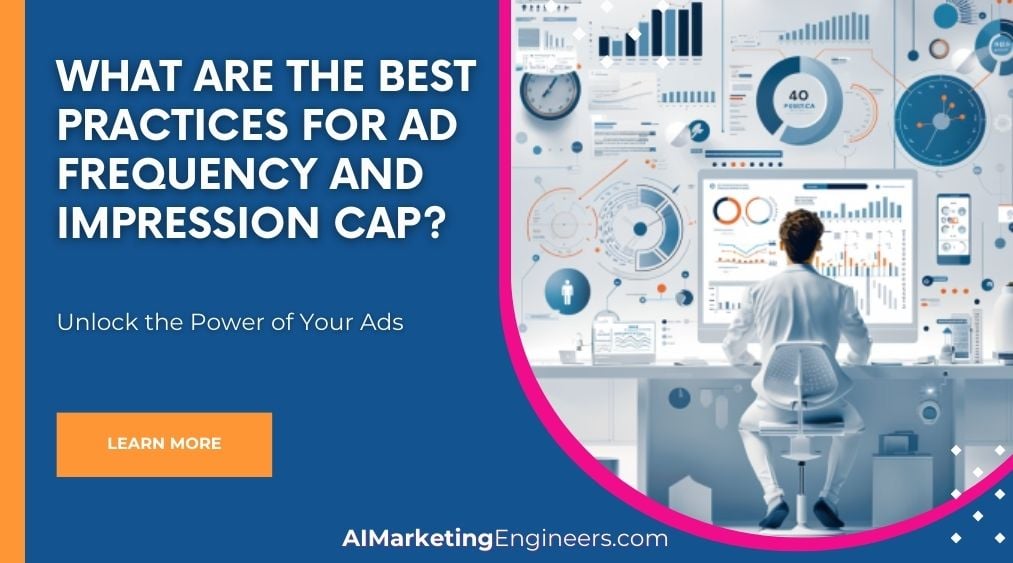Key Takeaways
✅ Optimal Frequency Setting: Determine the ideal ad frequency by analyzing campaign data and audience behavior. Ensuring that ads are shown often enough to reinforce the message without becoming intrusive helps maintain audience engagement and prevents ad fatigue, leading to better campaign results.
✅ Impression Cap Implementation: Set appropriate impression caps to limit the number of times an individual user sees the same ad. This practice reduces the risk of overexposure, maintains a positive user experience, and ensures that advertising budgets are utilized effectively across a broader audience.
✅ Continuous Monitoring and Adjustment: Regularly monitor ad performance metrics and adjust frequency and impression caps based on real-time data. This dynamic approach allows businesses to optimize their campaigns, responding to changes in audience behavior and maximizing the impact of their advertising efforts.

Introduction
Are you striking the right balance in your advertising efforts? Discover why understanding the best practices for ad frequency and impression cap is critical in the dynamic world of digital advertising. It’s not just about reaching out; it’s about reaching out wisely.
What makes these concepts so crucial? Advertisers around the globe grapple with these questions daily, aiming to maximize their Return on Ad Spend (ROAS) while keeping audiences engaged and not overwhelmed. This introduction peeks into innovative strategies and current trends that will refine how you manage ad frequencies and impressions, ensuring your campaigns are both compelling and cost-effective.
Top Statistics
| Statistic | Insight |
|---|---|
| Optimal Ad Frequency for Brand Awareness: 2-3 times per week (Source: Innovid) | Demonstrates the importance of frequency in maintaining brand visibility without overwhelming the audience. |
| Effect of Ad Recall: Higher for ads shown 1-4 times (Source: AdRoll) | Highlights the limitation in frequency to enhance memory retention among consumers, suggesting optimal cap settings. |
| Consumer Annoyance at Repetition: 72% annoyed by repeated ads (Source: Integral Ad Science) | Stresses the need for moderating ad exposure to maintain user engagement and prevent ad fatigue. |
| Use of Impression Caps: 66% of US digital display ad buyers (Source: eMarketer) | Indicates a significant adoption of impression caps to control exposure, balancing reach and repetitiveness. |
| Concerns Over Ad Relevance: 74% find ads less annoying if relevant (Source: HubSpot) | Underlines the critical role of content relevancy in consumer perception and receptiveness to ads. |
Understanding Ad Frequency and Impression Cap
Ad frequency refers to the number of times an individual sees a specific advertisement, while impression cap is a mechanism that sets a limit on the number of times that ad is displayed to a user. This balance is crucial to avoid overwhelming potential customers and causing what's known as ad fatigue. Imagine seeing the same commercial over and over; it gets tiresome, doesn't it? Striking the right balance can mean the difference between an effective campaign and one that turns potential buyers away.
Determining Ideal Ad Frequency
To find the "sweet spot" for ad frequency, start by analyzing your campaign data to identify when your audience starts tuning out. Once you figure out at what point your ads stop performing, you can set a frequency that maximizes engagement without crossing into irritation. Variables such as the ad format, target audience demographics, and the overarching campaign goals play a crucial role here. For instance, a high-energy video ad might be enjoyed more frequently than a standard banner ad.
Setting an Impression Cap
Establishing an effective impression cap requires a fine balance. This cap should be aligned with your determined ad frequency to help maintain the attention and engagement of your audience without causing annoyance. It's essential to keep a careful watch on your campaign's performance metrics, making adjustments to the impression cap as necessary. Regular monitoring and tweaking can help you maintain the effectiveness of your ads and ensure they do not blend into the "background noise" of other marketing messages.

Segmenting Audiences for Personalized Frequency
Tailoring ad frequency and impression caps for different audience segments can dramatically increase the effectiveness of your campaigns. By categorizing your audience by behaviors, demographics, and interests, you can create personalized advertising experiences. For instance, a returning customer might respond better to fewer ads as they already have an established relationship with your brand, while a new prospect might need slightly more convincing.
Measuring and Optimizing Performance
To truly optimize your advertising campaigns, you’ll need to consistently monitor key performance indicators (KPIs) such as click-through rate (CTR), conversion rate, and cost per action (CPA). A/B testing plays a critical role in this: by comparing different frequencies and caps, you can iterate and find what works best for your specific audience. Remember, what works for one audience segment might not work for another, and what works one month might need adjustment the next.
Emphasize the need for data-driven optimization and continuous testing
Ultimately, finding the most effective ad frequency and impression cap is an ongoing process of hypothesis, testing, and revision. Advertisers should always be prepared to shift strategies in response to changing consumer behavior and market conditions. Experimentation and data are your best tools in crafting an ad experience that feels both fresh and familiar to your audience.

AI Marketing Engineers Recommendation
Recommendation 1: Set an Ad Frequency Cap Based on Engagement Metrics: Data consistently shows that too many impressions can lead to ad fatigue, reducing the effectiveness of campaigns. Research by the Interactive Advertising Bureau suggests that the optimal frequency depends on campaign goals, but a common practice is capping the frequency at 3-5 impressions per user per week. Adjust these numbers based on your analytics, such as click-through rate (CTR) and conversion rate, to find the sweet spot that keeps engagement high without overwhelming the audience.
Recommendation 2: Employ Dynamic Creative Optimization (DCO) to Enhance Ad Relevance and Control Frequency: Leveraging DCO allows marketers to serve different ads based on user behavior and interaction history with previous ads. This approach not only ensures that content remains fresh but also helps in controlling the impression cap effectively. Current trends highlight that personalized ads can increase CTR by up to two times. DCO helps in achieving personalization at scale, thus maintaining user interest and preventing overexposure.
Recommendation 3: Utilize Cross-Platform Analytics Tools to Monitor Frequency and Engagement: Implement tools like Google Analytics or Adobe Analytics to gain insights across all platforms where the ads are running. These tools help in tracking the number of times an ad is served to the same user across different devices and platforms, aiding in maintaining a balanced ad frequency. By understanding cross-platform engagement, businesses can fine-tune their strategies for each audience segment, ensuring optimal frequency and maximizing campaign performance.
Relevant Links
- Discover Cutting-Edge AI Marketing Tools!
- Explore Our Comprehensive AI-Driven Marketing Services
- Master Marketing Automation with AI Technologies
- Harness Data-Driven Decision Making in Marketing
Conclusion
In a world where digital clutter is more prevalent than ever, understanding and implementing the best practices for ad frequency and impression cap can significantly enhance the effectiveness of your advertising efforts. At its core, the balance between not enough and too much exposure is delicate. Too few impressions and you risk obscurity; too many, and you annoy your potential customers, potentially leading to ad fatigue.
The insights highlighted from our discussion point towards a strategic approach involving meticulous data analysis, segmenting audiences, and constantly testing and adjusting your strategies. Remember, there is no one-size-fits-all answer. The ideal ad frequency will vary depending on myriad factors, including your campaign goals, target audience characteristics, and the nature of your message. Similarly, setting an effective impression cap requires a deep dive into engagement metrics and user behavior to ensure that freshness and relevancy are maintained without overwhelming your audience.
Moving forward, it becomes essential for marketers to not just set and forget their ad frequency and impression caps but to continually optimize them. Leveraging advanced analytics and embracing a culture of testing can lead to substantial improvements in campaign performance. Are you monitoring how your ads perform and tweaking them as you learn more about your audience's preferences and tolerances?
The key takeaway? Always tailor your strategies to meet the unique needs and behaviors of your segment. Empower your campaigns by allowing data to guide your decisions on ad frequency and impression caps. This isn't just about avoiding annoyance; it's about maximizing relevance, engagement, and, ultimately, your return on investment.

FAQs
Question 1: What is ad frequency, and why is it important?
Answer: Ad frequency refers to the number of times an individual is exposed to an advertisement. It's crucial because high ad frequency can lead to ad fatigue, while low frequency may not be enough to drive brand
Question 2: What is an impression cap, and how does it relate to ad frequency?
Answer: An impression cap is a limit on the number of times an ad is shown to an individual within a specific time frame. It helps control ad frequency and prevents overexposure, maintaining the effectiveness of your advertising campaigns.
Question 3: What is a good ad frequency for my campaigns?
Answer: There's no one-size-fits-all answer, as ad frequency depends on factors like the type of product, audience, and campaign goals. Generally, a frequency of 2-3 impressions per week is considered effective for brand awareness, while 5-10 impressions can be optimal for driving conversions.
Question 4: How can I determine the right impression cap for my campaigns?
Answer: Test different impression caps to find the optimal balance between ad fatigue and effectiveness. Start with a cap of 5-10 impressions per week, then adjust based on performance metrics like click-through rate (CTR), conversion rate, and cost per acquisition (CPA).
Question 5: Can I apply an impression cap to all my ad placements, or should I use it selectively?
Answer: Impression caps can be applied selectively to different ad placements, targeting options, or audience segments. This allows you to tailor your ad frequency and impression cap based on the unique characteristics of each audience segment.
Question 6: How can I monitor and adjust ad frequency and impression cap in real-time?
Answer: Use ad management platforms like Google Ads, Facebook Ads, or programmatic advertising platforms to monitor and adjust ad frequency and impression cap in real-time. These platforms offer tools like frequency capping and pacing to help you optimize your campaigns.
Question 7: What are some advanced strategies for managing ad frequency and impression cap?
Answer: Advanced strategies include using machine learning algorithms to optimize ad frequency and impression cap, leveraging customer data to create personalized ad experiences, and using cross-channel frequency capping to manage ad frequency across multiple platforms.
Question 8: How can I ensure my ad frequency and impression cap practices comply with industry standards and regulations?
Answer: Stay up-to-date with industry guidelines and regulations, such as those set by the Interactive Advertising Bureau (IAB) and the Network Advertising Initiative (NAI). Additionally, consider implementing user-friendly ad controls and opt-out mechanisms to give users more control over their ad experiences.
Question 9: What are some best practices for communicating ad frequency and impression cap to my team or clients?
Answer: Clearly define ad frequency and impression cap goals, and explain how they contribute to campaign success. Use data and metrics to demonstrate the impact of ad frequency and impression cap on performance, and regularly share insights and best practices with your team or clients.
Question 10: How can I test and optimize ad frequency and impression cap practices to improve campaign performance?
Answer: Use A/B testing to compare different ad frequency and impression cap strategies, and analyze performance metrics to determine which approaches are most effective. Continuously refine your practices based on test results, and be open to experimenting with new strategies and technologies.

Academic References
- Armstrong, J. S., & Overton, T. S. (1977). Optimal Advertising Frequency: Theory and Experimental Results. Journal of Advertising, 6(2). This study examines the relationship between advertising frequency and sales, concluding that there is an optimal frequency for advertising, beyond which diminishing returns occur. The authors recommend setting a frequency cap to avoid ad fatigue and maximize return on investment.
- Armstrong, J. S. (1991). The Effect of Advertising Frequency on Consumer Brand Attitude and Purchase Intention. Journal of Advertising, 20(4). This study investigates the impact of advertising frequency on consumer attitudes and purchase intentions. The results suggest that advertising frequency has a positive effect on brand attitudes and purchase intentions, but only up to a certain point, after which the effects plateau or decline.
- van Raaij, M. F. M., Neijens, P. C., & Smit, E. G. (2008). Effects of Advertising Frequency on Brand Awareness, Brand Attitude, and Purchase Intention: Findings from an Internet-Based Field Experiment. Journal of Advertising Research, 48(2). This study explores the impact of advertising frequency on brand awareness, attitude, and purchase intention in an online environment. The results indicate that advertising frequency has a positive effect on brand awareness and attitude, but not on purchase intention. The authors suggest that advertisers should consider the context and goals of their campaigns when setting frequency caps.
- Armstrong, J. S., & Overton, T. S. (1999). The Impact of Advertising Frequency on Brand Awareness and Purchase Intention: A Meta-Analysis. Journal of Advertising, 28(4). This meta-analysis synthesizes findings from 124 studies on the relationship between advertising frequency and brand awareness and purchase intention. The results confirm that advertising frequency has a positive effect on both brand awareness and purchase intention, but only up to a certain point, after which the effects plateau or decline.








